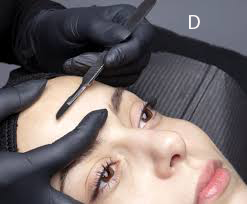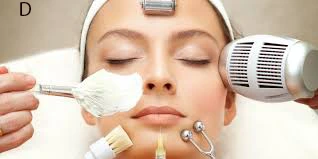Dermablading is also known as “dermablasting.” Skin treatment is a non-invasive procedure that exfoliates the skin layer by gently scraping away fine vellus hair, commonly referred to as peach fuzz. It is a common facial treatment for enhancing the texture and look of skin. The skin is treated gently, scraping it at a 45-degree angle, the reduction of acne scars on other skin areas. Dermaplaning can help.
Introduction
Dermablading is a relatively new cosmetic skin treatment that improves skin tone, texture, and appearance by combining aspects of dermaplaning and microneedling. Usually, painful discomfort can even have a faint tickling or scraping feel to it. The top layer of your skin is shaved off by your healthcare provider using a specialized tool. Dermaplaining is another hair removal procedure that some people get. Your hair will regrow, so it is just a short-term solution. However, the procedure is performed anywhere on the body.

Treatment details
Dead Skin cells, peach fuzz, or fine vellus hair are also carefully scraped away with the help of a sterile surgical blade. This prepares the skin and also helps to absorb active ingredients more effectively. By creating a tiny chance, skin microneedling or nano needling improves serum absorption and also promotes collagen production. It depends on the client’s requirements or skin sensitivity; this step may change.
Before treatment

For overall skin health, drink plenty of water and also fragrance fragrance-free moisturizer to support the skin. To promote general skin health, also drink a lot of water to keep your skin more hydrated. Do not use any active ingredient on the day of treatment, and also make sure your skin is free of makeup and clean. The chance of guaranteeing that your skin is in the best possible state to take advantage of the dermaplaning exfoliating properties. Being well prepared, your skin lowers the chance of irritations.
Products with retinoids, scrubs, and exfoliating brushes are also avoided. Before dermablading, to ensure the best results and avoid irritation most important to prepare the skin. Before undergoing dermablading or dermaplaning treatment, you should stop using any exfoliating products. Avoid using acids, waxing, and laser treatment because they make your skin more sensitive. For at least a week beforehand, away from any other resurfacing. To protect your skin from UV damage, always wear sunscreen and also stay out of the direct sunlight. Sunburned or sensitive skin cannot be treated. You should make sure your skin is more hydrated in a gentle way.
During dermablading
A specially formulated cosmetic pigments are carefully applied to the skin during the treatment of dermablading. Dermablading also provides immediate results and offers a smooth, natural-looking finish. It is a non-invasive solution. The practitioner may also use setting powers or spray to enhance the durability of the coverage during the treatment. The result is also immediate and can last for hours and even days. while it is not a permanent solution, and also offers an excellent temporary result.

To remove any oil or impurity that may also affect your makeup adherence, the skin is thoroughly cleaned. High-performance cosmetic pigments are applied to the skin during the treatment of dermablading. The goal of dermablading is to provide an even-toned also enhances confidence without the need for an invasive procedure. During this treatment, using either a brush, sponge, or airbrush, the pigment products are applied. To remove the oil and dirt, a trained specialist typically begins the cleaning the skin.
After treatment
It is most important to always keep hydrated, and also soften the skin by applying moisturiser. Do not apply other skin care and cosmetic products. The skin will become smoother, more visibly, and also more uniform appearance. At the end of the day is important to clean your face with a non-irritating makeup. Give an immediate result, and the skin will have a natural look. Most dermablading can last up to 12 to 16 hours. Clients should also avoid touching or rubbing the treated areas, especially in the first hours, is important to maintain the integrity of the coverage.
The skin will appear smoother, more even-toned, and also discolored after the treatment. The most immediate result, and also the coverage, can last for up to 16 hours or more. Skin dermablasting is a non-invasive and temporary solution. To keep the skin more hydrated, moisturizing after removal is also recommended. Sensitive or acne-prone skin should cleanse the area gently at he end of the day using.
Benefits
Dermaplaning is a non-invasive cosmetic procedure and is also involves removing fine vellus hairs from the face and also exfoliating the top layer of dead skin cells with a sterile surgical scalpel. It also offers a number of advantages for the skin, which is provided by a qualified specialist. Dermablading has more advantages.
Smooth skin
Eliminate fine hair and also dead skin cells, leaving skin feeling incredibly smooth right away and soft.
More vibrant complexion
By promoting cell turnover, exfoliating exposes a never more radiant layer of skin beneath. improves light reflection, reflecting light better, also making your complexion look bright and more luminous.
Better absorption for the product
The removal of dead skin cells makes it easier for skincare products to penetrate. Dermablading is better for the absorption of the product.
Risks in dermablading
There are still risks and side effects in dermablading. After the dermablation, a mild redness is common. Small cuts may also occur; these are usually superficial and heal quickly. If hygiene is not maintained, infection may be possible. After treatment, if skin is not protected from the sun, hyperpigmentation or dark spots may also occur. Those with darker skin tones may also more at risk. In the treated areas, heat, redness, and swelling increased. The removal of the top skin layer also makes the skin more sensitive, and redness increases. The skin can irritate active acne and also spread bacteria across the skin.
Conclusion
Non-invasive skin care treatment that also offers immediate results and immediate benefits such as smoother texture, a radiant glow, and improved product absorption. Sensitivity to the skin is one of the most important risks. It can lead to hyperpigmentation if the skin is not protected from the sun. If the skin is not shielded from the sun, hyperpigmentation may also result. Dmblanding is performed by a qualified expert. In summary, dermaplaning can be beneficial or also safe, but it is not completely risk-free. If you are thinking about dermanlaning, it is a good fit for your skin. After dermabrasion skin’s protective outer layer is also removed. The long-term goal is to improve skin health.

FAQs
Q#1 Is dermablading beneficial for all types of skin?
Dermarolling is not safe for many types of skin. It may not be suitable for; most sensitive skin conditions, for example, rosacea, eczema, psoriasis
active acne, or cystic acne
Q#2 Can I do dermaplaning at home?
Yes, dermaplaning can be done at home, but with caution. Dermaplaning tools are less at home, which also makes them safer but also less effective. Some risks are also included,
- Uneven exfoliations
- May infection also occur
- Spreading bacteria
- Nicks or cuts
Q#3 What are the side effects of dermablending?
There are some common and temporary side effects of dermablending. A slight irritation, Dry or tight skin also feeling, and temporary redness. Some are less common and more effective:
- Infection or a small cut
- Hyperpigmentations
- Clogged pores or breakouts
Q#4 What should I avoid after drmaplaning?
- Steam facial
- Direct sunlight
- Do not use hot water
- Heavy makeup
- Harsh skin products
- Hyderating serum
